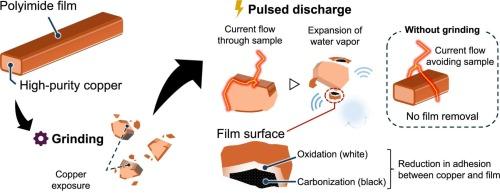脉冲放电磨削预处理从聚酰亚胺漆包线中回收高纯铜
IF 7.1
2区 环境科学与生态学
Q1 ENGINEERING, ENVIRONMENTAL
引用次数: 0
摘要
从废漆包线中回收高品位铜是满足日益增长的铜需求的一个有希望的策略。然而,废漆包线回收是具有挑战性的,因为必须去除紧密结合的绝缘膜。聚酰亚胺薄膜由于其高耐热性和耐溶剂性而特别难以去除,很少有研究报道成功去除聚酰亚胺薄膜。本研究提出了一种物理方法,通过研磨处理和脉冲放电去除漆包线上的聚酰亚胺膜。单独的脉冲放电不能剥离这种薄膜;然而,研磨预处理部分去除了聚酰亚胺薄膜,这抑制了电流流向目标片,允许脉冲放电过程有效地剥离薄膜。优化研磨方法增加了样品通电的概率,从而提高了脉冲放电步骤的效率。采用该组合处理,膜去除率达93.0 wt%。分析结果表明,薄膜在局部高温区碳化剥落,薄膜表面发生自由基驱动氧化。同时,聚酰亚胺薄膜内部既不发生碳化也不发生氧化,因为聚酰亚胺的高介电强度阻止了电流通路的形成。这些结果表明,聚酰亚胺分解过程中有害物质和温室气体的产生是可以抑制的。本文报告的研究结果表明,脉冲放电作为一种快速去除废漆包线膜的物理方法,具有很大的潜力,而且对环境的影响很小。本文章由计算机程序翻译,如有差异,请以英文原文为准。

High-purity copper recovery from polyimide-enameled wires using pulsed discharge with a grinding pre-treatment
A promising strategy to meet growing demands for copper is to recover high-grade copper from spent enameled wires. However, spent enamel-wire recycling is challenging because the tightly bonded insulating films must be removed. Polyimide films are particularly difficult to remove because of their high heat and solvent resistance, and few studies have reported successful removal of polyimide films. The present study proposes a physical method to remove polyimide films from enameled wires by applying a grinding treatment and pulsed discharge. Pulsed discharge alone could not peel off such films; however, the grinding pre-treatment partially removed the polyimide film, which inhibited current flow to the target pieces, allowing the pulsed discharge process to effectively peeled off the film. Optimizing the grinding method increased the probability of energizing the sample, thereby enhancing the efficiency of the pulsed discharge step. The film removal rate reached 93.0 wt% using the developed combination treatment. Analytical results indicated that the film was peeled via carbonization in local high-temperature areas with radical-driven oxidation on the film surface. Meanwhile, neither carbonization nor oxidation occurred inside the polyimide film because the high dielectric strength of polyimide prevented the formation of current pathways. These results suggest that the generation of harmful substances and greenhouse gases during polyimide decomposition can be suppressed. The findings reported herein demonstrate the significant potential of pulse discharge as a physical method for rapidly removing films from spent enameled wires with low environmental impact.
求助全文
通过发布文献求助,成功后即可免费获取论文全文。
去求助
来源期刊

Waste management
环境科学-工程:环境
CiteScore
15.60
自引率
6.20%
发文量
492
审稿时长
39 days
期刊介绍:
Waste Management is devoted to the presentation and discussion of information on solid wastes,it covers the entire lifecycle of solid. wastes.
Scope:
Addresses solid wastes in both industrialized and economically developing countries
Covers various types of solid wastes, including:
Municipal (e.g., residential, institutional, commercial, light industrial)
Agricultural
Special (e.g., C and D, healthcare, household hazardous wastes, sewage sludge)
 求助内容:
求助内容: 应助结果提醒方式:
应助结果提醒方式:


